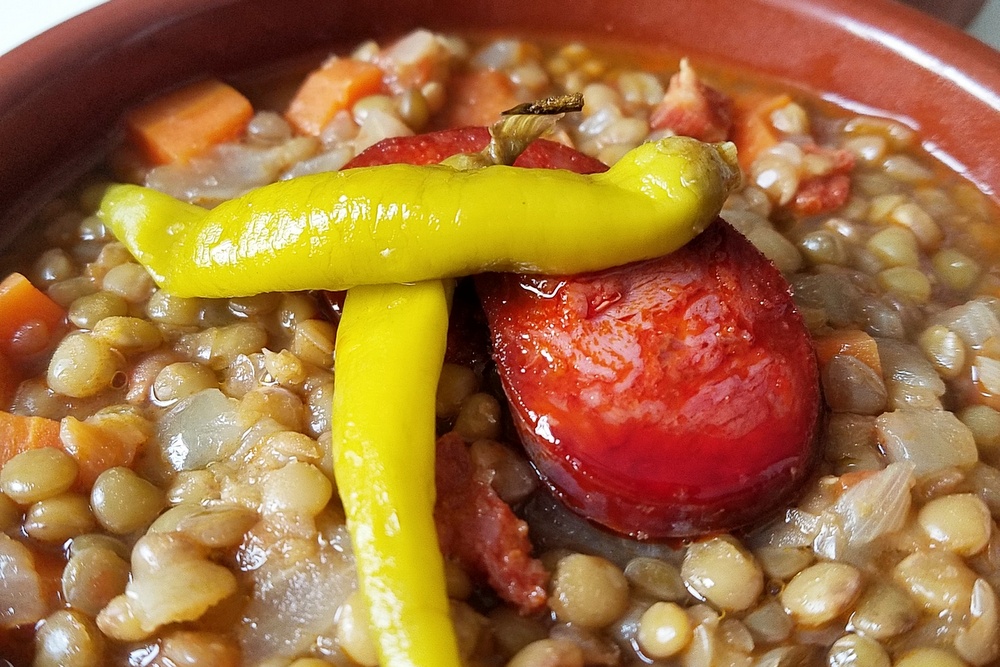An interesting photographic exhibition in Lanzarote caught my eye this week. The exhibition, which was presented by local students, brought together 300 photographs from the family albums of their grandparents and great grandparents, which reflected life on the island in the last century.
In one photograph, the great grandparents of one student are shown threshing lentils, which were grown on the island. Lentils are usually regarded as one of the world’s healthiest foods and it was interesting to see that they were grown and harvested in Lanzarote, as well as the other Canary Islands.
The island of Lanzarote is just sixty miles off the coast of the Sahara. It is a dry and volcanic island, with six to eight inches of rain in a good year and much less during a drought; both this and its volcanic geology became this island’s destiny. Serious problems for islanders were caused by volcanic disasters. As with all the Canary Islands, such conditions determined the crops that could be grown to ensure survival in sometimes wretched economic and climatic conditions. One of the answers was to be lentils.
Long before the Spanish conquest of the Canary Islands, people used the rich, fertile earth to grow a range of subsistence crops, which included lentils. The lentil is one of the oldest and hardiest foods in the world, and there is no legume more resistant to arid land than the lentil. It needs very little water to grow and can survive the hottest or coldest of climates.
Lentils originated in central Asia and have been eaten since prehistoric times and are one of the first foods known to be cultivated, since seeds dating back 8000 years have been found in archaeological sites in the Middle East. Archaeologists even discovered traces of lentils buried with the dead in Egyptian pyramids. The humble lentil had reached mythical status and was praised for its ability to enlighten the mind, even in the afterlife. In Catholic countries, such as Spain and the Canary Islands, lentils have long been used as a staple food during Lent.
Lentil stew is a popular dish in the Canary Islands, and often served with potatoes, chorizo and vegetables. I am also told that the addition of garlic croutons and red Canary wine together with crusty bread makes a comforting and wholesome dish, and best found in many of the small, traditional family-run restaurants on the islands. Lentils do not need to be soaked before cooking, have multiple uses in the kitchen, and their flavour enhances any vegetable or meat ingredient. It is no wonder that they have been a treasured foodstuff since early times.
As a vegetarian for many years, I have long been aware of the high nutritional properties of the humble lentil. They are an excellent source of cholesterol-lowering fibre, as well as having an ability to manage blood sugar levels following a meal. Lentils contain seven of the most important minerals, including B-vitamins and protein, and with virtually no fat. Indeed, just a cupful of cooked lentils will set you back around 200 calories, so they are great for anyone on a diet.
The fibre content helps to overcome digestive disorders, such as irritable bowel syndrome and prevents constipation. There are also huge benefits to the heart; according to food intake studies, lentils were associated with an 82 per cent reduction in risk from heart attacks due to their fibre, as well as from the significant amounts of folate and magnesium. Lentils are rich in iron and, unlike red meat, are not rich in calories or fat, which makes them ideal for those who require increased levels of iron, including growing children and adolescents.
I am very fond of pasta dishes, but try to avoid eating them too often, because they can be very fattening. I have recently discovered pasta made entirely from lentils, which can now be easily purchased from some of the major supermarkets. At last, I can enjoy pasta without worrying about the calories.
This one old photograph of a couple threshing lentils on this beautiful island reminded me of the immense value of the humble lentil, which can be rightly called “an ancient crop for modern times”. If you haven’t yet eaten a lentil dish, or used them within a meal, I recommend that you do. As for me, I’m off to enjoy a lentil bake and a glass of red Lanzarote wine for lunch.
If you enjoyed this article, take a look at my websites: http://barriemahoney.com and http://thecanaryislander.com or read my latest book, ‘Living in Spain and the Canary Islands’ (ISBN: 9780995602724). Available in paperback, as well as Kindle editions.
Join me on Facebook: @barrie.mahoney
© Barrie Mahoney





